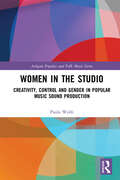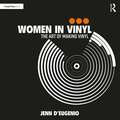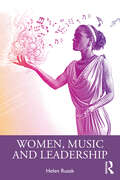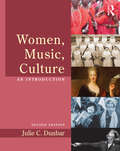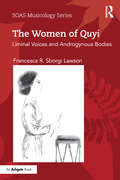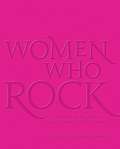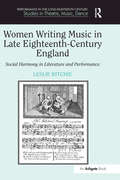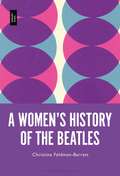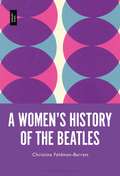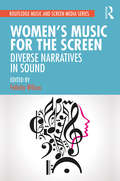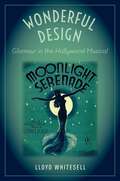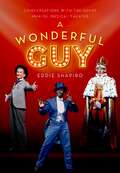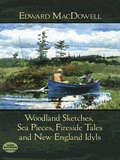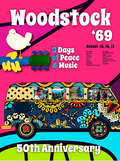- Table View
- List View
Women in the Studio: Creativity, Control and Gender in Popular Music Sound Production (Ashgate Popular and Folk Music Series)
by Paula WolfeThe field of popular music production is overwhelmingly male dominated. Here, Paula Wolfe discusses gendered notions of creativity and examines the significant under-representation of women in studio production. Wolfe brings an invaluable perspective as both a working artist-producer and as a scholar, thereby offering a new body of research based on interviews and first-hand observation. Wolfe demonstrates that patriarchal frameworks continue to form the backbone of the music industry establishment but that women’s work in the creation and control of sound presents a potent challenge to gender stereotyping, marginalisation and containment of women’s achievements that is still in evidence in music marketing practices and media representation in the digital era.
Women in the Studio; Creativity, Control and Gender in Popular Music Production: Creation, Control And Gender In Popular Music Sound Production (Ashgate Popular And Folk Music Ser.)
by Paula WolfeThe field of popular music production is overwhelmingly male dominated. Here, Paula Wolfe discusses gendered notions of creativity and examines the significant under-representation of women in studio production. Wolfe brings an invaluable perspective as both a working artist-producer and as a scholar, thereby offering a new body of research based on interviews and first-hand observation. Wolfe demonstrates that patriarchal frameworks continue to form the backbone of the music industry establishment but that women’s work in the creation and control of sound presents a potent challenge to gender stereotyping, marginalisation and containment of women’s achievements that is still in evidence in music marketing practices and media representation in the digital era.
Women in Vinyl: The Art of Making Vinyl
by Jenn D’EugenioWomen in Vinyl: The Art of Making Vinyl provides a comprehensive guide to the world of vinyl, with a focus on empowerment, diversity, and inclusion, designed to both demystify the vinyl community and highlight the vital role women and minority groups play in shaping the industry.Divided into each step of the process, the book provides a detailed overview of the vinyl manufacturing process, from lacquer cutting, electroplating, and record pressing, to the roles of record labels, distribution, DJs, and more. With interviews and profiles from global professionals throughout, the book is a first-of-its-kind guide to the vinyl industry and the women who are blazing trails within it. Women in Vinyl is an essential resource for professionals, hobbyists, and students interested in the process of making vinyl, including those who want to deepen their understanding of the vinyl medium and its role in shaping the music industry, as well as for those interested in the work of the organization Women in Vinyl.
Women in Vinyl: The Art of Making Vinyl
by Jenn D’EugenioWomen in Vinyl: The Art of Making Vinyl provides a comprehensive guide to the world of vinyl, with a focus on empowerment, diversity, and inclusion, designed to both demystify the vinyl community and highlight the vital role women and minority groups play in shaping the industry.Divided into each step of the process, the book provides a detailed overview of the vinyl manufacturing process, from lacquer cutting, electroplating, and record pressing, to the roles of record labels, distribution, DJs, and more. With interviews and profiles from global professionals throughout, the book is a first-of-its-kind guide to the vinyl industry and the women who are blazing trails within it. Women in Vinyl is an essential resource for professionals, hobbyists, and students interested in the process of making vinyl, including those who want to deepen their understanding of the vinyl medium and its role in shaping the music industry, as well as for those interested in the work of the organization Women in Vinyl.
Women, Music and Leadership
by Helen RusakWomen, Music and Leadership offers a wide-ranging survey of women in musical leadership and their experiences, highlighting women’s achievements and considering how they negotiate the challenges of the leadership space in music. Women have always participated in music as performers, teachers, composers and professionals, but remain underrepresented in leadership positions. Covering women’s leadership across a wide variety of roles and musical genres, this book addresses women in classical music, gospel, blues, jazz, popular music, electronic music and non-Western musical contexts, and considers women working as composers, as conductors, and in music management and the music business. Each chapter includes several case studies of women’s careers, exploring their groundbreaking contributions to music and the challenges they faced as leaders. Connecting management theory and leadership research with feminist musicology, this book paints a new picture of women’s major contributions as leaders in music and their ongoing struggles for equity. It will be relevant to students and scholars in arts and music management, as well as all those studying music, gender or leadership, and women music professionals.
Women, Music and Leadership
by Helen RusakWomen, Music and Leadership offers a wide-ranging survey of women in musical leadership and their experiences, highlighting women’s achievements and considering how they negotiate the challenges of the leadership space in music. Women have always participated in music as performers, teachers, composers and professionals, but remain underrepresented in leadership positions. Covering women’s leadership across a wide variety of roles and musical genres, this book addresses women in classical music, gospel, blues, jazz, popular music, electronic music and non-Western musical contexts, and considers women working as composers, as conductors, and in music management and the music business. Each chapter includes several case studies of women’s careers, exploring their groundbreaking contributions to music and the challenges they faced as leaders. Connecting management theory and leadership research with feminist musicology, this book paints a new picture of women’s major contributions as leaders in music and their ongoing struggles for equity. It will be relevant to students and scholars in arts and music management, as well as all those studying music, gender or leadership, and women music professionals.
Women, Music, Culture: An Introduction
by Julie C. DunbarWomen, Music, Culture: An Introduction, Second Edition is the first undergraduate textbook on the history and contribution of women in a variety of musical genres and professions, ideal for students in courses in both music and women's studies. A compelling narrative, accompanied by over 50 guided listening examples, brings the world of women in music to life, examining a community of female musicians, including composers, producers, consumers, performers, technicians, mothers, and educators in art music and popular music. The book features a wide array of pedagogical aids, including a running glossary and a comprehensive companion website with streamed audio tracks, that help to reinforce key figures and terms. This new edition includes a major revision of the Women in World Music chapter, a new chapter in Western Classical "Work" in the Enlightenment, and a revised chapter on 19th Century Romanticism: Parlor Songs to Opera. 20th Century Art Music.
Women, Music, Culture: An Introduction
by Julie C. DunbarWomen, Music, Culture: An Introduction, Second Edition is the first undergraduate textbook on the history and contribution of women in a variety of musical genres and professions, ideal for students in courses in both music and women's studies. A compelling narrative, accompanied by over 50 guided listening examples, brings the world of women in music to life, examining a community of female musicians, including composers, producers, consumers, performers, technicians, mothers, and educators in art music and popular music. The book features a wide array of pedagogical aids, including a running glossary and a comprehensive companion website with streamed audio tracks, that help to reinforce key figures and terms. This new edition includes a major revision of the Women in World Music chapter, a new chapter in Western Classical "Work" in the Enlightenment, and a revised chapter on 19th Century Romanticism: Parlor Songs to Opera. 20th Century Art Music.
The Women of Quyi: Liminal Voices and Androgynous Bodies (SOAS Studies in Music)
by Francesca R. Sborgi LawsonWhy has the female voice—as the resonant incarnation of the female body—inspired both fascination and ambivalence? Why were women restricted from performing on the Chinese public stage? How have female roles and voices been appropriated by men throughout much of the history of Chinese theatre? Why were the women of quyi—a community of Chinese female singers in Republican Tianjin—able to become successful, respected artists when other female singers and actors in competing performance traditions struggled for acceptance? Drawing substantially on original ethnographic fieldwork conducted in the 1980s and 1990s, Francesca R. Sborgi Lawson offers answers to these questions and demonstrates how the women of quyi successfully negotiated their sexuality and vocality in performance. Owing to their role as third-person narrators, the women of quyi bridged the gender gap, creating an androgynous persona that de-emphasized their feminine appearance and, at the same time, allowed them to showcase their female voices on public stages—places that had been previously unwelcoming to female artists. This is a story about female storytellers who sang their way to respectability and social change in the early decades of the twentieth century by minimizing their bodies in order to allow their voices to be heard.
The Women of Quyi: Liminal Voices and Androgynous Bodies (SOAS Studies in Music)
by Francesca R. Sborgi LawsonWhy has the female voice—as the resonant incarnation of the female body—inspired both fascination and ambivalence? Why were women restricted from performing on the Chinese public stage? How have female roles and voices been appropriated by men throughout much of the history of Chinese theatre? Why were the women of quyi—a community of Chinese female singers in Republican Tianjin—able to become successful, respected artists when other female singers and actors in competing performance traditions struggled for acceptance? Drawing substantially on original ethnographic fieldwork conducted in the 1980s and 1990s, Francesca R. Sborgi Lawson offers answers to these questions and demonstrates how the women of quyi successfully negotiated their sexuality and vocality in performance. Owing to their role as third-person narrators, the women of quyi bridged the gender gap, creating an androgynous persona that de-emphasized their feminine appearance and, at the same time, allowed them to showcase their female voices on public stages—places that had been previously unwelcoming to female artists. This is a story about female storytellers who sang their way to respectability and social change in the early decades of the twentieth century by minimizing their bodies in order to allow their voices to be heard.
Women Who Rock: Bessie to Beyonce. Girl Groups to Riot Grrrl.
by Evelyn McDonnellA stellar and unprecedented celebration of 104 musical artists, Women Who Rock is the most complete, up-to-date history of the evolution, influence, and importance of women in music. A gorgeous gift book, it includes a stunning, specially commissioned, full-color illustrated portrait of every musician and group. From Bessie Smith and The Supremes to Joan Baez, Madonna, BeyoncéAmy Winehouse, Dolly Parton, Sleater-Kinney, Taylor Swift, and scores more, women have played an essential and undeniable role in the evolution of popular music including blues, rock and roll, country, folk, glam rock, punk, and hip hop. Today, in a world traditionally dominated by male artists, women have a stronger influence on popular music than ever before. Yet, not since the late nineteen-nineties has there been a major work that acknowledges and pays tribute to the female artists who have contributed to, defined, and continue to make inroads in music. In Women Who Rock, writer and professor of journalism Evelyn McDonnell leads a team of women rock writers and pundits in an all-out celebration of 104 of the greatest female musicians. Organized chronologically, the book profiles each artist and places her in the context of both her genre and the musical world at large. Sidebars throughout recall key moments that shaped both the trajectory of music and how those moments influenced or were influenced by women artists. With full-color illustrated portraits by women artists, Women Who Rock will be THE long-awaited gift book for every music fan, feminist, and female rocker, young and old musicians.
Women Writing Music in Late Eighteenth-Century England: Social Harmony in Literature and Performance (Performance In The Long Eighteenth Century: Studies In Theatre, Music, Dance Ser.)
by Leslie RitchieCombining new musicology trends, formal musical analysis, and literary feminist recovery work, Leslie Ritchie examines rare poetic, didactic, fictional, and musical texts written by women in late eighteenth-century Britain. She finds instances of and resistance to contemporary perceptions of music as a form of social control in works by Maria Barth mon, Harriett Abrams, Mary Worgan, Susanna Rowson, Hannah Cowley, and Amelia Opie, among others. Relating women's musical compositions and writings about music to theories of music's function in the formation of female subjectivities during the latter half of the eighteenth century, Ritchie draws on the work of cultural theorists and cultural historians, as well as feminist scholars who have explored the connection between femininity and performance. Whether crafting works consonant with societal ideals of charitable, natural, and national order, or re-imagining their participation in these musical aids to social harmony, women contributed significantly to the formation of British cultural identity. Ritchie's interdisciplinary book will interest scholars working in a range of fields, including gender studies, musicology, eighteenth-century British literature, and cultural studies.
Women Writing Music in Late Eighteenth-Century England: Social Harmony in Literature and Performance
by Leslie RitchieCombining new musicology trends, formal musical analysis, and literary feminist recovery work, Leslie Ritchie examines rare poetic, didactic, fictional, and musical texts written by women in late eighteenth-century Britain. She finds instances of and resistance to contemporary perceptions of music as a form of social control in works by Maria Barth mon, Harriett Abrams, Mary Worgan, Susanna Rowson, Hannah Cowley, and Amelia Opie, among others. Relating women's musical compositions and writings about music to theories of music's function in the formation of female subjectivities during the latter half of the eighteenth century, Ritchie draws on the work of cultural theorists and cultural historians, as well as feminist scholars who have explored the connection between femininity and performance. Whether crafting works consonant with societal ideals of charitable, natural, and national order, or re-imagining their participation in these musical aids to social harmony, women contributed significantly to the formation of British cultural identity. Ritchie's interdisciplinary book will interest scholars working in a range of fields, including gender studies, musicology, eighteenth-century British literature, and cultural studies.
A Women’s History of the Beatles
by Christine Feldman-BarrettA Women's History of the Beatles is the first book to offer a detailed presentation of the band's social and cultural impact as understood through the experiences and lives of women. Drawing on a mix of interviews, archival research, textual analysis, and autoethnography, this scholarly work depicts how the Beatles have profoundly shaped and enriched the lives of women, while also reexamining key, influential female figures within the group's history. Organized topically based on key themes important to the Beatles story, each chapter uncovers the varied and multifaceted relationships women have had with the band, whether face-to-face and intimately or parasocially through mediated, popular culture. Set within a socio-historical context that charts changing gender norms since the early 1960s, these narratives consider how the Beatles have affected women's lives across three generations. Providing a fresh perspective of a well-known tale, this is a cultural history that moves far beyond the screams of Beatlemania to offer a more comprehensive understanding of what the now iconic band has meant to women over the course of six decades.
A Women’s History of the Beatles
by Christine Feldman-BarrettA Women's History of the Beatles is the first book to offer a detailed presentation of the band's social and cultural impact as understood through the experiences and lives of women. Drawing on a mix of interviews, archival research, textual analysis, and autoethnography, this scholarly work depicts how the Beatles have profoundly shaped and enriched the lives of women, while also reexamining key, influential female figures within the group's history. Organized topically based on key themes important to the Beatles story, each chapter uncovers the varied and multifaceted relationships women have had with the band, whether face-to-face and intimately or parasocially through mediated, popular culture. Set within a socio-historical context that charts changing gender norms since the early 1960s, these narratives consider how the Beatles have affected women's lives across three generations. Providing a fresh perspective of a well-known tale, this is a cultural history that moves far beyond the screams of Beatlemania to offer a more comprehensive understanding of what the now iconic band has meant to women over the course of six decades.
Women's Leadership in Music: Modes, Legacies, Alliances (Musik und Klangkultur #63)
by Iva Nenic Linda CimardiVarious modes of women's contemporary cultural, social and political leadership can be found in music. Informed by different histories and culturally bound social mores but also by a comparative perspective, the contributors of this volume ask what can be considered leadership in culture from women's point of view. They deconstruct the notion of leadership as corporative and career-related modes of success by showing how women's agency, power and negotiation in and through music can and should be considered as empowering, transformative and role-modeling. By interweaving several disciplinary perspectives - from ethnomusicology, musicology and cultural management to sociology and anthropology - this volume aims to substantially contribute to the study of women's leadership.
Women's Music for the Screen: Diverse Narratives in Sound
by Felicity WilcoxWomen’s Music for the Screen: Diverse Narratives in Sound shines a long-overdue light on the works and lives of female-identifying screen composers. Bringing together composer profiles, exclusive interview excerpts, and industry case studies, this volume showcases their achievements and reflects on the systemic gender biases women have faced in an industry that has long excluded them. Across 16 essays, an international array of contributors present a wealth of research data, biographical content, and musical analysis of film, television, and video game scores to understand how the industry excludes women, the consequences of these deficits, and why such inequities persist – and to document women’s rich contributions to screen music in diverse styles and genres.The chapters amplify the voices of women composers including Bebe Barron, Delia Derbyshire, Wendy Carlos, Anne Dudley, Rachel Portman, Hildur Guðnadóttir, Mica Levi, Winifred Phillips, and more. From the mid-twentieth century to the present, and from classic Hollywood scores to pioneering electronic music, these are the stories and achievements of the women who have managed to forge successful careers in a male-dominated arena. Suitable for researchers, educators, and students alike, Women’s Music for the Screen urges the screen music industry to consider these sounds and stories in a way it hasn’t before: as voices that more accurately reflect the world we all share.
Women's Music for the Screen: Diverse Narratives in Sound
by Felicity WilcoxWomen’s Music for the Screen: Diverse Narratives in Sound shines a long-overdue light on the works and lives of female-identifying screen composers. Bringing together composer profiles, exclusive interview excerpts, and industry case studies, this volume showcases their achievements and reflects on the systemic gender biases women have faced in an industry that has long excluded them. Across 16 essays, an international array of contributors present a wealth of research data, biographical content, and musical analysis of film, television, and video game scores to understand how the industry excludes women, the consequences of these deficits, and why such inequities persist – and to document women’s rich contributions to screen music in diverse styles and genres.The chapters amplify the voices of women composers including Bebe Barron, Delia Derbyshire, Wendy Carlos, Anne Dudley, Rachel Portman, Hildur Guðnadóttir, Mica Levi, Winifred Phillips, and more. From the mid-twentieth century to the present, and from classic Hollywood scores to pioneering electronic music, these are the stories and achievements of the women who have managed to forge successful careers in a male-dominated arena. Suitable for researchers, educators, and students alike, Women’s Music for the Screen urges the screen music industry to consider these sounds and stories in a way it hasn’t before: as voices that more accurately reflect the world we all share.
Wonderful Design: Glamour in the Hollywood Musical
by Lloyd WhitesellAs one of the most beloved and beguiling genres of entertainment, the film musical wears its style ostentatiously. The genre allows for hyperbolic expression, extravagant sonic and visual decor, and extremely stylized forms of movement and performance. By staging a glittering spectacle, by releasing a current of lush sentiment, by unveiling a world of elegance and romance, the film musical woos us with patterns, textures, finesse and sensory display. In this book, author Lloyd Whitesell asks what, exactly, makes film musicals so glamorous. As he argues, glamour projects an aura of ethereality or sophistication by way of suave deportment, sensuous textures, elevated styles, and aesthetically refined effects. Glamour, in other words, is what unites "Cheek to Cheek" from Top Hat and the title song from Beauty and the Beast, each a sonic evocation of luxury, sparkle, grace, and finesse. Whitesell redirects our attention from visual cues like sequins and evening gloves to explore how glamour resides in the sonic. Discussing dozens of musical numbers, analyzing ingenious orchestration, and appraising the distinctive styles of favorite musical stars, Whitesell illuminates fundamental traits of the genre, its aesthetic strategies, and cultural ambitions.
WONDERFUL DESIGN C: Glamour in the Hollywood Musical
by Lloyd WhitesellAs one of the most beloved and beguiling genres of entertainment, the film musical wears its style ostentatiously. The genre allows for hyperbolic expression, extravagant sonic and visual decor, and extremely stylized forms of movement and performance. By staging a glittering spectacle, by releasing a current of lush sentiment, by unveiling a world of elegance and romance, the film musical woos us with patterns, textures, finesse and sensory display. In this book, author Lloyd Whitesell asks what, exactly, makes film musicals so glamorous. As he argues, glamour projects an aura of ethereality or sophistication by way of suave deportment, sensuous textures, elevated styles, and aesthetically refined effects. Glamour, in other words, is what unites "Cheek to Cheek" from Top Hat and the title song from Beauty and the Beast, each a sonic evocation of luxury, sparkle, grace, and finesse. Whitesell redirects our attention from visual cues like sequins and evening gloves to explore how glamour resides in the sonic. Discussing dozens of musical numbers, analyzing ingenious orchestration, and appraising the distinctive styles of favorite musical stars, Whitesell illuminates fundamental traits of the genre, its aesthetic strategies, and cultural ambitions.
A Wonderful Guy: Conversations with the Great Men of Musical Theater
by Eddie ShapiroFascinating, never-before-published interviews with Broadway's leading men offer behind-the-scenes looks at the careers of some of the most beloved perfomers today. In A Wonderful Guy, a follow up to Nothing Like a Dame: Conversations with the Great Women of Musical Theater, theatre journalist Eddie Shapiro sits down for intimate, career-encompassing conversations with nineteen of Broadway's most prolific and fascinating leading men. Full of detailed stories and reflections, his conversations with such luminaries as Joel Grey, Ben Vereen, Norm Lewis, Gavin Creel, Cheyenne Jackson, Jonathan Groff and a host of others dig deep into each actor's career; together, these chapters tell the story of what it means to be a leading man on Broadway over the past fifty years. Alan Cumming described Nothing Like a Dame, as "an encyclopedia of modern musical theatre via a series of tender meetings between a diehard fan and his idols. Because of Eddie Shapiro's utter guilelessness, these women open up and reveal more than they ever have before, and we get to be the third guest at each encounter." A Wonderful Guy brings more fly-on-the-wall opportunities for fans to savour, students to study, and even the unindoctrinated to understand the life of the performing artist.
A Wonderful Guy: Conversations with the Great Men of Musical Theater
Fascinating, never-before-published interviews with Broadway's leading men offer behind-the-scenes looks at the careers of some of the most beloved perfomers today. In A Wonderful Guy, a follow up to Nothing Like a Dame: Conversations with the Great Women of Musical Theater, theatre journalist Eddie Shapiro sits down for intimate, career-encompassing conversations with nineteen of Broadway's most prolific and fascinating leading men. Full of detailed stories and reflections, his conversations with such luminaries as Joel Grey, Ben Vereen, Norm Lewis, Gavin Creel, Cheyenne Jackson, Jonathan Groff and a host of others dig deep into each actor's career; together, these chapters tell the story of what it means to be a leading man on Broadway over the past fifty years. Alan Cumming described Nothing Like a Dame, as "an encyclopedia of modern musical theatre via a series of tender meetings between a diehard fan and his idols. Because of Eddie Shapiro's utter guilelessness, these women open up and reveal more than they ever have before, and we get to be the third guest at each encounter." A Wonderful Guy brings more fly-on-the-wall opportunities for fans to savour, students to study, and even the unindoctrinated to understand the life of the performing artist.
Woodland Sketches, Sea Pieces, Fireside Tales and New England Idyls
by Edward MacDowellEdward MacDowell (1860-1908) was America's most prominent nineteenth-century composer. Championed by Franz Liszt, he was one of the first U.S. composers to gain international recognition. A leading exponent of the Romantic tradition, he was a prolific composer for the piano. This outstanding collection presents his best, most characteristic works, reprinted from original editions. They include:Woodland Sketches, Op. 51Sea Pieces, Op. 55Fireside Tales, Op. 61New England Idyls, Op. 62These beautiful and affecting compositions reflect not only MacDowell's poetic Romanticism but also his virtuosic skills as a pianist, which won him an international reputation as a concert artist. Intermediate- and advanced-level pianists will appreciate the lyric intensity and ebullient spirit of these pieces.
Woodstock '69: 50th Anniversary
by Peter MurrayThe Woodstock Music & Art Fair was held in the United States in 1969 which attracted an audience of more than 400,000. Scheduled for August 15–17 on a dairy farm in the Catskill Mountains of southern New York State, northwest of New York City, it ran over to Monday, August 18. Billed as "An Aquarian Exposition: 3 Days of Peace &Music", it was held at Max Yasgur's 600-acre dairy farm near the hamlet of White Lake in the town of Bethel. Located in Sullivan County, Bethel is 43 miles (70 km) southwest of the town of Woodstock in adjoining Ulster County. During the sometimes rainy weekend, 32 acts performed outdoors before an audience of more than 400,000 people. It is widely regarded as a pivotal moment in popular music history, as well as the definitive nexus for the larger counterculture generation. This book captures the history and magical moments of the event like never before.
Woodstock Scholarship: An Interdisciplinary Annotated Bibliography
by Jeffrey N. GattenSince August 1969, the Woodstock Music and Art Fair looms large when recounting the history and impact of the baby boom generation and the societal upheavals of the Sixties. Scholars study the sociological, political, musical, and artistic impact of the event and use it as a cultural touchstone when exploring alternative perspectives or seeking clarity. This interdisciplinary annotated bibliography records the details of over 400 English-language resources on the Festival, including books, chapters, articles, websites, transcriptions and videos. Divided into six main subsections―Culture & Society, History, Biography, Music, Film, Arts & Literature―for ease of consultation Woodstock Scholarship sheds light on all facets of a key happening in our collective history. Throughout the 1960s, popular music became increasingly reflective and suggestive of the rising political and social consciousness of the youth culture. Examples can be seen in the development of the protest song genre within the folk music boom of the early Sixties and the marriage of lifestyle to music first reflected by The Beatles with fashion, followed by psychedelic music with the emerging drug culture. Woodstock was where these themes coalesced, thus becoming the defining and last great moment of the 1960s. However, Woodstock also represented an abundant amount of experiences and ideas and moments. Thus, when exploring the complicated accounts and numerous facets of America during the turbulent Sixties one discovers scholarship on the key subjects, such as the Vietnam War or the Civil Rights Movement, often considering and debating the importance, relevance, and epic nature of Woodstock. Multiple narratives emerge: a radical engagement of the hippie movement, an overt commercial exploitation of youth culture, a political statement. Woodstock scholarship does not stand alone as field of study, but it is at the cross-road of a number of disciplines―music history, cultural studies, sociology, arts and literature, media studies, politics and economics. Providing full bibliographical details and concise, informative annotation for each entry, Woodstock Scholarship is an essential tool for students, scholars, teachers, and librarians in all these areas, as well as for anyone seeking a deeper understanding of both the Woodstock Music and Art Fair phenomenon and of the confluence of music, commerce and politics.
